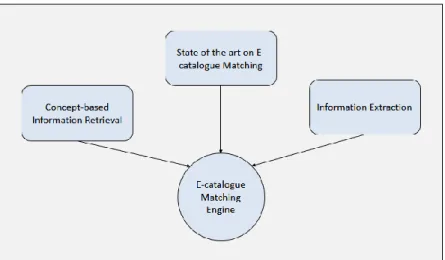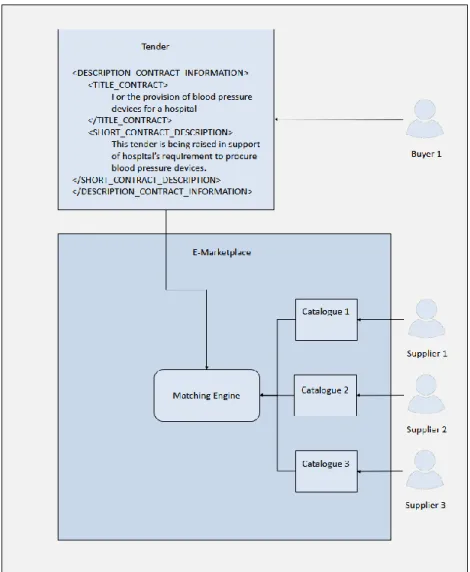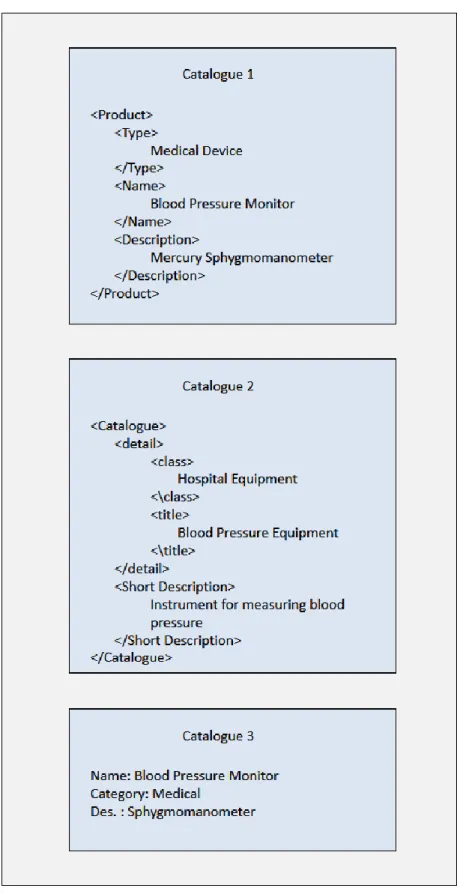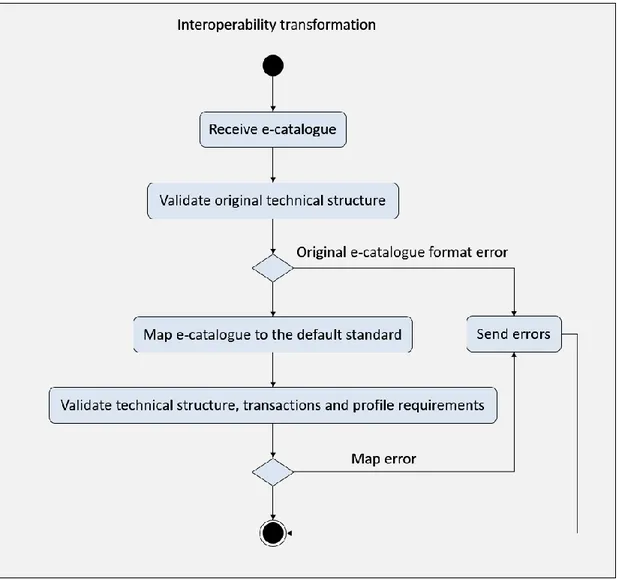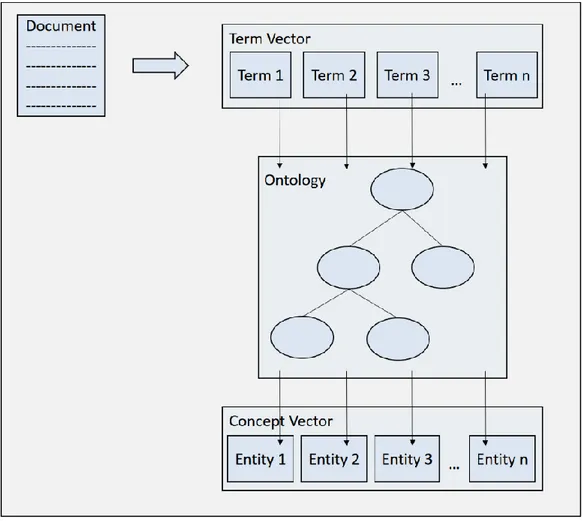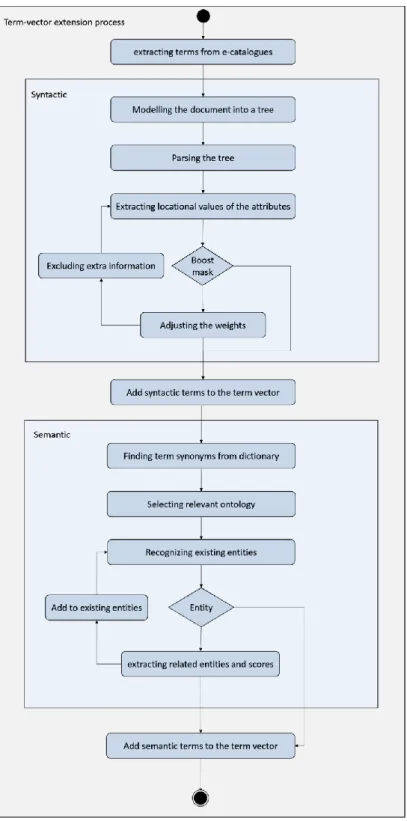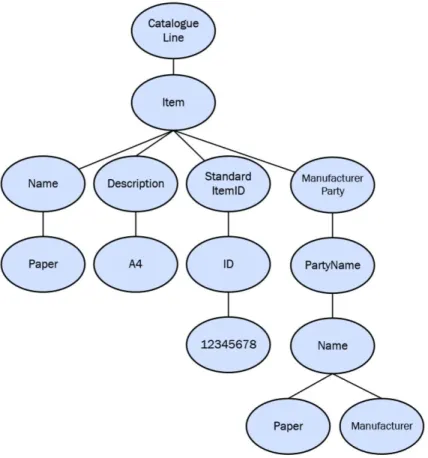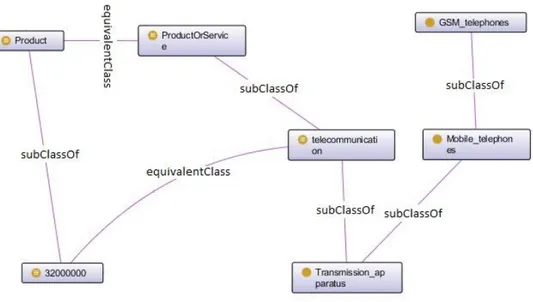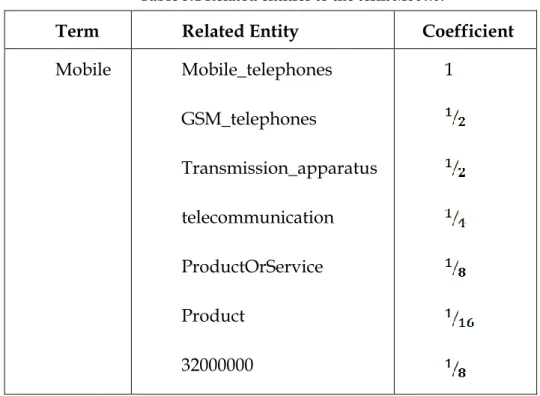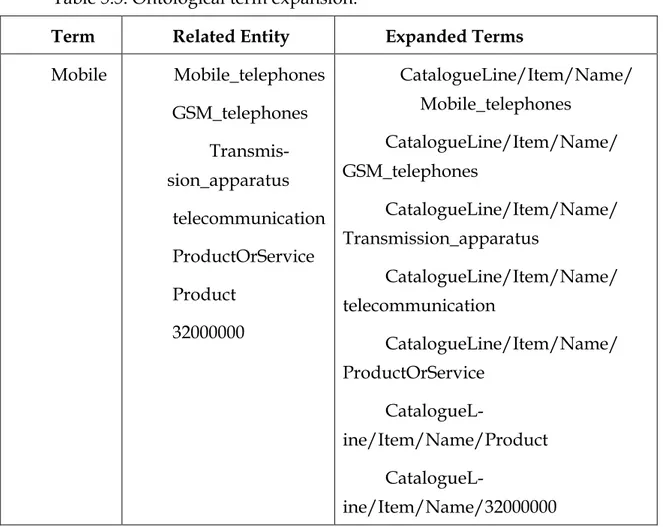Setembro, 2016
Ahmad Mehrbod
[Nome completo do autor]
[Nome completo do autor]
[Nome completo do autor]
[Nome completo do autor]
[Nome completo do autor]
[Nome completo do autor]
[Nome completo do autor]
Master em Engenharia Computação
[Habilitações Académicas] [Habilitações Académicas] [Habilitações Académicas] [Habilitações Académicas] [Habilitações Académicas] [Habilitações Académicas] [Habilitações Académicas]
Semantic and Syntactic Matching of Heterogeneous
e-Catalogues
[Título da Tese]
Dissertação para obtenção do Grau de Doutor em Engenharia Industrial
Dissertação para obtenção do Grau de Mestre em [Engenharia Informática]
Orientador: António Grilo, Professor Auxiliar com Agregação, FCT- UNL
Júri:
Presidente: Fernando José Pires Santana
Arguentes: João Pedro Mendonça de Assunção da Silva Carlos Eduardo Dias Coutinho
Vgais: Virgílio António Cruz Machado
Richardo Luís Rosa Jardim Gonçalves António Carlos Bárbara Grilo
Semantic and Syntactic Matching of Heterogeneous e-Catalogues
Copyright © Ahmad Mehrbod, Faculdade de Ciências e Tecnologia, Universidade Nova de Lisboa.
A Faculdade de Ciências e Tecnologia e a Universidade Nova de Lisboa têm o direito, perpétuo e sem limites geográficos, de arquivar e publicar esta dissertação através de exemplares impressos reproduzidos em papel ou de forma digital, ou por qualquer outro meio conhecido ou que venha a ser inventado, e de a divulgar através de repositórios científicos e de admitir a sua cópia e distribuição com objectivos educacionais ou de investigação, não comerciais, desde que seja dado crédito ao autor e editor.
v
vii Acknowledgements
I would like to express my gratitude to all of those that directly or indi-rectly contributed and supported my work.
Firstly, I would like to express my sincere gratitude to my supervisor Pro-fessor Dr. Antonio Grilo for the continuous support of my Ph.D. study and re-lated research, for his patience, motivation, and immense knowledge. His guid-ance helped me in all the time of research and writing of this thesis. I could not have imagined having a better advisor and mentor for my Ph.D. study.
Besides my supervisor, I would like to thank the rest of my CAT commit-tee: Prof. Ricardo Gonçalves and Prof. João Pedro Mendonça.
I would also like to thank Professor Virgilio Cruz-Machado for his bril-liant comments and suggestions and all my professors in Industrial Engineering department of Universidade Nova de Lisboa.
I sincerely acknowledge the financial support from project VortalSo-cialApps, co-financed by VORTAL and IAPMEI and the European Funds QREN COMPETE, and also would like to thank Fundação da Ciência e Tecno-logia for supporting the research center UNIDEMI through the grant Projeto Estratégico PEst-OE/EME/UI0667/2014.
Last but not the least, I would like to thank my family: my parents and to my brother and sisters for supporting me in all my life. I would also like to thank all of my friends Aneesh Zutshi, Izunildo Cabral, Pedro Cruz, Pedro Tavares, Raphaela Vidal and Tahere Nodehi from UNIDEMI and João Gameiro, Tiago Ferreira, Hugo Felício, Nuno Milagres and Rui Barreira from Vortal who supported me during this research work. At the end I would like express ap-preciation to my beloved wife Samira for her understanding, encouragement and support that made this burden possible and my lovely children Anahita and Arad who are my motivation to continue.
ix
Abstract
In e-procurement, companies use e-catalogues to exchange product infor-mation with business partners. Matching e-catalogues with product requests helps the suppliers to identify the best business opportunities in B2B Marketplaces. But various ways to specify products and the large variety of e-catalogue formats used by different business actors makes it difficult.
This Ph.D. thesis aims to discover potential syntactic and semantic rela-tionships among product data in procurement documents and exploit it to find similar e-catalogues. Using a Concept-based Vector Space Model, product data and its semantic interpretation is used to find the correlation of product data. In order to identify important terms in procurement documents, standard e-catalogues and e-tenders are used as a resource to train a Product Named Entity Recognizer to find B2B product mentions in e-catalogues.
The proposed approach makes it possible to use the benefits of all availa-ble semantic resources and schemas but not to be dependent on any specific as-sumption. The solution can serve as a B2B product search system in e-Procurement platforms and e-Marketplaces.
Keywords: Information Retrieval, e-Procurement, e-Catalogue, e-Tender, Semantic Search, Ontology, Vector Space Model, Product Classification System.
xi
Resumo
Em contratação eletrónica, as empresas utilizam catálogos eletrónicos para a troca de informações sobre o produto com os parceiros de negócio. Correspondência de catálogos electrónicos com os produtos procurados ajuda os fornecedores a identificar as melhores oportunidades de negócio em mercados electrónicos B2B. Mas as várias formas de especificar os produtos e a grande variedade de formatos de catálogos eletrónicos utilizados por diferentes atores de negócios faz com que a correspondência seja difícil.
Esta tese de doutoramento tem como objetivo explorar potenciais relações sintáticas e semânticas entre os dados do produto em documentos de contratação e utililá-las para descobrir catálogos semelhantes. De forma a identificar termos importantes em documentos de contratação, catálogos standardizados e licitações eletrónicas são utilizados como um recurso para treinar um “Product Named Entity Recognizer” de forma a descobrir produtos referenciados em catálogos eletrónicos.
A abordagem proposta torna possível usar os benefícios de todos os esquemas e recursos semânticos disponíveis mas não deve ser dependente de nenhum pressuposto específico. A solução pode servir como um sistema de procura de produtos B2B em plataformas de contratação eletrónica e mercados eletrónicos.
Palavras-chave: Recuperação de informação, Contratação eletrónica, Catálogos eletrónicos, Licitações eletrónicas, Procura semântica, Ontologia, Vector Space Model, Sistema de classificação de produtos.
xiii
Definitions and Abbreviations
Term Description
B2B Business to Business
CPV Common Procurement Vocabulary
CRF Conditional Random Field
CSV Comma Separated Values
cXML commerce XML
E-Business Electronic Business
E-Catalogue Electronic Catalogue
E-Procurement Electronic Procurement
IT Information Technologies
NER Named Entity Recognition
NLP Natural Language Processing
OWL Web Ontology Language
PNER Product Named Entity Recognition
POS Part of Speech
xiv
TED Tenders Electronic Daily
UBL Universal Business Language
UNGM United Nations Global Marketplace
UNSPSC United Nations Standard Products and
Services Code
VSM Vector Space Model
xCBL XML Common Business Library
xv
Content
1 INTRODUCTION ... 1
1.1 MATCHING HETEROGENEOUS E-CATALOGUES ... 1
1.2 RESEARCH QUESTIONS ... 4
1.3 PROPOSITIONS ... 6
1.4 RESEARCH METHODOLOGY ... 9
1.4.1 Collection of Literature Review ... 9
1.4.2 Development of the matching engine ...11
1.4.3 Validation of the matching mechanism ...12
1.4.4 Data Collection ...14
1.5 STRUCTURE OF THE THESIS ... 14
2 E-CATALOGUE MATCHING ... 17
2.1 E-PROCUREMENT CATALOGUES ... 17
2.2 MATCHING PROBLEM ... 21
2.3 PRIVATE AND PUBLIC PROCUREMENT ... 25
2.4 MATCHING SCENARIOS ... 28 2.5 SUMMARY ... 30 3 INTEGRATION MODELS ... 33 3.1 STANDARDIZATION ... 34 3.2 UNIFORM SCHEMA ... 38 3.3 ONTOLOGICAL MODEL ... 41 3.4 ONTOLOGY MERGING ... 45 3.5 ONTOLOGY ALIGNMENT ... 47 3.6 SUMMARY ... 48
xvi
4.1 SIMILARITY-BASED MATCHING... 53
4.2 VECTOR SPACE MODEL ... 56
4.3 CONCEPT-BASED VSM ... 58
4.4 INFORMATION EXTRACTION ... 60
4.5 PRODUCT NAMED ENTITY RECOGNITION ... 63
4.6 SUMMARY ... 67
5 E-CATALOGUE MATCHING ENGINE ... 69
5.1 SYNTACTIC E-CATALOGUE MATCHING ... 72
5.1.1 Multilevel Term Definition ... 72
5.1.2 Boosting Masks ... 79
5.2 SEMANTIC E-CATALOGUE MATCHING ... 80
5.2.1 Ontology Deriving ... 81 5.2.2 Ontological Matching... 83 5.2.3 Synonym Matching ... 91 5.3 P2P-PRODUCT NER ... 95 5.3.1 Bootstrapping ... 97 5.3.2 Learning-based B2B NER ... 100 5.4 METHODOLOGY STEPS ... 106 5.5 SUMMARY ... 108 6 VALIDATION ... 111 6.1 EVALUATION MEASURES ... 112 6.2 SUPPLIER FINDER... 116 6.2.1 Test Scenario ... 116 6.2.2 Data Gathering ... 117 6.2.3 Test Definition ... 118 6.2.4 Test Results ... 119 6.3 OPPORTUNITY FINDER ... 122 6.3.1 Test Scenario ... 122 6.3.2 Test definition ... 123 6.3.3 Data Gathering ... 125 6.3.4 Test Results ... 128
6.4 MULTI RESOURCE MATCHING ... 139
6.4.1 Test Scenario ... 139
6.4.2 Test definition ... 141
6.4.3 Data Gathering ... 143
6.4.4 Test Results ... 146
6.5 B2BPRODUCT NERACCURACY TEST ... 151
6.5.1 Test Scenario ... 151
xvii
6.5.3 Data Gathering ... 153
6.5.4 Test Results on automatic annotated test datasets ... 154
6.5.5 Test Results on manually annotated test datasets ... 156
6.6 SUMMARY ... 157
7 CONCLUSIONS ...159
7.1 THE PROBLEM AND THE MOTIVATION ... 159
7.2 CONTRIBUTION OF THIS THESIS ... 160
7.3 AREAS FOR FURTHER DEVELOPMENT AND RESEARCH ... 163
8 BIBLIOGRAPHY ...165
xviii
List of Figures
FIGURE 1.1RESEARCH AREAS THAT LEAD TO THE DEVELOPMENT OF THE MATCHING MECHANISM ... 10
FIGURE 2.1 E-PROCUREMENT PHASES ... 18
FIGURE 2.2MATCHING PROBLEM ... 23
FIGURE 2.3HETEROGENEITY OF E-CATALOGUES. ... 24
FIGURE 3.1 E-CATALOGUES TRANSFORMATION TO A UNIFORM SCHEMA ... 40
FIGURE 4.1:MATRIX OF TERM-VECTORS ... 56
FIGURE 4.2DEVIATION BETWEEN ANGLES IN VECTOR SPACE ... 57
FIGURE 4.3 CONCEPT-BASED VSM ... 60
FIGURE 5.1TERM-VECTOR EXTENSION PROCESS ... 70
FIGURE 5.2A PART OF A STRUCTURED E-CATALOGUE (D1) ... 74
FIGURE 5.3TREE MODEL PRESENTATION OF E-CATALOGUE D1 ... 75
FIGURE 5.4SIMILAR E-CATALOGUES TO D1 ... 75
FIGURE 5.5.COEFFICIENTS FOR THE SAMPLE E-CATALOGUE ... 80
FIGURE 5.6.TERM EXPANSION PROCESS ... 85
FIGURE 5.7.RELATED ENTITIES EXTRACTION PROCESS ... 86
FIGURE 5.8.RELEVANT ONTOLOGY SELECTION ... 87
FIGURE 5.9A SAMPLE ONTOLOGY BASED ON CPV ... 90
FIGURE 5.10A PART OF A STRUCTURED E-CATALOGUE ... 90
FIGURE 5.11BOOTSTRAPPING PROCESS... 98
FIGURE 5.12B2B-PRODUCT NER TRAINING AND TEST PROCESS ... 100
FIGURE 5.13TITLE OF A TENDER NOTICE FROM TED ... 102
FIGURE 5.14CPV REFERENCES OF A TENDER NOTICE FROM TED... 103
FIGURE 5.15B2B-PRODUCTS DICTIONARY ... 103
FIGURE 5.16SAMPLE ANNOTATED CORPUS ... 104
FIGURE 5.17NAMED ENTITY EXTRACTION FROM B2B CONTEXT ... 105
FIGURE 6.1SUPPLIER FINDER TEST... 119
FIGURE 6.2E-CATALOGUE MATCHING SCORES ... 121
xix
FIGURE 6.4PRECISION-RECALL CURVE FOR THE SAMPLE TEST SET ... 130
FIGURE 6.5PRECISION-RECALL CURVE FOR COMPREHENSIVE TEST SET ... 135
FIGURE 6.6 HISTOGRAM OF MAP RESULT SETS ... 137
FIGURE 6.7CLASSIFICATION VOCABULARIES TEST ... 142
FIGURE 6.8TEST RESULTS IN THREE DIFFERENT STATES ... 146
xxi
List of Tables
TABLE 1.1TEST OBJECTIVES FOR DIFFERENT TEST CASES ... 12
TABLE 5.1ALL POSSIBLE TERMS FOR D1 ... 77
TABLE 5.2ADDITIONAL TERMS FOR THE LAST ENTRY IN TABLE 5.1 ... 78
TABLE 5.3SYNTACTIC TERMS FOR MOBILE IN FIGURE 5.10. ... 91
TABLE 5.4RELATED ENTITIES TO THE TERM MOBILE. ... 91
TABLE 5.5.ONTOLOGICAL TERM EXPANSION... 93
TABLE 5.6.SYNONYMOUSLY TERM EXPANSION. ... 93
TABLE 6.1OVERVIEW OF THE TEST CASES ... 112
TABLE 6.2TEDTEST REPOSITORY BASED ON MAIN ACTIVITIES ... 127
TABLE 6.3 AVERAGE INTERPOLATED PRECISION-RECALL VALUES ... 129
TABLE 6.4PRECISION-RECALL FOR COMPREHENSIVE TEST SET ... 131
TABLE 6.5MAPVALUES ... 134
TABLE 6.6F-TEST TWO-SAMPLE FOR VARIANCES ... 136
TABLE 6.7F-TEST TWO-SAMPLE FOR VARIANCES ... 136
TABLE 6.8 T-TEST: KEYWORD-BASED VS.E-CATALOGUE MATCHING ... 138
TABLE 6.9 T-TEST: KEYWORD-BASED VS.E-CATALOGUE MATCHING USING NER ... 138
TABLE 6.10 TEST REPOSITORY ... 144
TABLE 6.11 TEST RESULTS USING UNSPSC VOCABULARY... 147
TABLE 6.12 TEST RESULT USING CPV VOCABULARY ... 148
TABLE 6.13 TEST RESULTS USING BOTH UNSPSC AND CPV VOCABURALRIES ... 149
TABLE 6.14B2B-PRODCUT NEREVALUATION RESULTS ... 155
1
1
Introduction
1.1 Matching Heterogeneous e-Catalogues
With increasing competitive pressures, manufacturers must continually find ways to reduce costs, increase efficiency, and reduce lead time while at the same time seek greater access to markets in cost effective ways. E-procurement platforms help manufacturers reduce costs by having greater access to raw ma-terial suppliers while at the same time help them to sell across greater geogra-phies and increase their market competitiveness (Ramkumar & Jenamani, 2012). This comes as no surprise, given one of the key competitive priorities for the 21st century is the maximization of Internet-based technologies such as e-procurement (Pearcy, Parker, & Giunipero, 2008).
catalogues play a critical role in e-procurement marketplaces. E-catalogues are procurement documents that explain the products subject of the procurement process. They can be used in both the tendering (pre-award) and the purchasing (post-award) processes. Companies use e-catalogues to ex-change product information with business partners. Suppliers use e-catalogues to describe goods or services that they offer for sale. Meanwhile, buyers may use e-catalogues to specify the items that they want to buy (Ghimire, Jardim-Goncalves, & Grilo, 2013)(Ghimire et al., 2013).
Matching a product request from a buyer with products e-catalogues that have been provided by the suppliers, helps companies to reduce the efforts
2
needed to find partners in e-marketplaces (Kim, Kim, & Lee, 2002)(Lee et al., 2007).
The large variety of e-catalogue formats (Schmitz, Leukel, & Dorloff, 2005) which are used by various companies is one of the major challenges in the matching process. Since each business actor may use a different structure, clas-sification and identification code for describing e-catalogues, it is not easy to match a product with the e-catalogue requested by another partner (Lee et al., 2007). This heterogeneity makes it difficult and time-consuming to integrate and query e-catalogues (Chen et al., 2010a).
While there are too many different standards for e-catalogues and product classifications in use, often companies do not follow standard formats and pre-fer to have their individual structures (Chen, Li, & Zhang, 2010). Hence, we of-ten encounter a plethora of catalogue formats ranging from unstructured text to well-structured XML documents. This diversity results in the syntactic hetero-geneity of e-catalogues.
While syntactic diversity comes from various schemas and formats in use, often the heterogeneity problem has a semantic dimension as well. Semantic heterogeneity of e-catalogues is due to various approaches to express and mod-el the product concepts by different actors. Business partners may express the same concept using different keywords, classifications or taxonomies that cause to get diverse results in searching for the same product (Chen, Li, & Zhang, 2010).
The traditional approach to integrate e-catalogues is to transform different formats, schemas and taxonomies into a uniform catalogue model (Ghimire, Jardim-Goncalves, & Grilo, 2013)(Kim, Kim, & Lee, 2002)(Chen et al., 2010a). Usually, ontologies are used to define such uniform models and hand-coded rules are used to transform the catalogues to relative knowledge bases. In the homogeneous space that will be provided by the uniform model, the products can be defined or converted to well-structured objects that can be matched effi-ciently.
But because of variety of known or even unknown structures that are used by various companies in an marketplace, achieving a uniform model for
e-3
catalogues is usually not practical. Development of a uniform e-catalogue mod-el requires a precise and detailed understanding of each of the various formats of catalogues (Benatallah et al., 2006). However, there is always a chance to en-counter a new concept or schema which may cause difficulties in its interpreta-tion. Furthermore, the transformation of the existing data to a uniform model can be costly, unscalable and tedious.
Since in the area of e-catalogues we often face up to plenty of models and developing a universal model is crucial, in this research work a practical, ex-pandable and realistic mechanism to solve the problem is proposed. To reach this goal, this research work uses Vector Space Model that is common in the world of web search engines and customizes it to solve the matching problem of the e-catalogues.
Vector Space Model is an algebraic model for presenting text documents as vectors which is the base of many search techniques and document similarity methods. Using this presentation, the document can be compared and the search queries can be answered using simple mathematics. Vector Space Model (VSM) has several attractive properties and can be applied to both semantic (Mukerjee, Porter, & Gherman, 2011)(Widdows, 2008) and syntactic (Manning et al., 2008)(Carmel et al., 2002) aspects of the search problem. Although the basic functionality of Vector Space Model refers to keyword search in textual data, several efforts have been done to eliminate many of the problems associ-ated with exact term matching and expand it to semantic matching in a wide range of search applications as well. Semantic search is a data searching tech-nique in which a search query aims to not only find keywords, but to determine the intent and contextual meaning of the words used for search in order to im-prove search accuracy.
In semantic matching, traditional keyword-based VSM is adapted with vectors that are comprised of semantically defined entities, instead of keywords (Mehrbod, Zutshi, & Grilo, 2014b). Domain-specific semantic search typically involves recognizing entities in the query and search data and matching them up to entities that make sense in the particular domain. In order to reach this goal, the existing entities in the search domain should be extracted using Named Entity Recognition techniques. The product information usually is
em-4
bedded in text which imposes a barrier on collecting, comparing and analysing the product information. Here the problem is to match free-text, semi-structured or even semi-structured product descriptions to their related entities in a semantic resource. In simple words, the problem is to detect a known product in a piece of data.
Named Entity Recognition (NER) extracts information automatically from a given set of documents, thus requiring lower human effort than other ap-proaches to semantics, such as hand-coded knowledge bases and ontologies (Turney & Pantel, 2010).
The proposed method uses Vector Space Model and Named Entity Recog-nition to measure the syntactic and semantic similarity ratio of providers’ e-catalogues with a buyer’s e-catalogue or call for tender. Instead of developing semantic or syntactic models and combining them to universal models that try to cover all possible cases, the idea here is to use any available syntax and se-mantic information of e-catalogues to interpret product data without any model assumption. The matching process uses the syntactic and semantic metadata for interpreting each e-catalogue as much as the information is available for the system. But is not dependent on this information and uses the basic mechanism of VSM for tolerating unknown formats.
1.2 Research Questions
Matching products queries on buyer’s side to the product data on suppli-er’s side can help both parties to achieve business goals in digital marketplaces. Companies use e-procurement tools, processes and techniques to purchase their required goods and services. The companies usually share their product data in the form of e-catalogues in B2B e-marketplaces. While suppliers publish their offered products and services in the form of e-catalogues, buying organizations can also benefit from the usage of the buyer e-catalogues to announce their needs.
The shared data can be a valuable resource for search engines to find the best suitable results for the business actors in the marketplaces. The product
da-5
ta can lead the matching mechanism in finding and recommending the right suppliers to a buyer. In this sense, the search engine uses the product data from an e-catalogue in order to find similar and related e-catalogues that is referred as e-catalogue matching.
The main barrier on matching product data with the same or similar products mentioned in different catalogues is the heterogeneity of e-catalogues. Since various companies utilize different structures, schemas and standards to create the catalogues, it is not straightforward to identify similar products especially in multi-resource marketplaces.
Some procurement marketplaces especially in public sector try to force beneficiary companies to follow a specific standard. Though the standards do not cover all aspects of the problem and sometimes are difficult to integrate with in-house procurement systems, companies barely follow e-catalogue standards.
In order not to impose fixed structures to the companies, the e-catalogue heterogeneity problem is treated using data integration models. The idea be-hind it is to uniform all e-catalogues which come from different resources into a covering data model that makes the matching process easy. But achieving such model and transforming the catalogues to the model is a critical issue of this method. This leads to the first research question of this Thesis:
Research Question 1
How can buyers and suppliers match their e-catalogues in an efficient way, with no restrictions regarding data integration models?
Since the integration process can be difficult, costly and not extendable, the question here is how to exploit the product data without restricting the e-catalogues in an integrated model. Hence, the problem is to develop a flexi-ble method which is aflexi-ble to find out various e-catalogues regardless of the structure and the content model. How can this method figure out the con-tent of the e-catalogues without transforming them into a reference model? How will it exploit the possible available structures, models and standards? And how will it tolerate missing such knowledge?
6
Moreover, several documents have been used during the procurement pro-cess. Among these documents, public tender notices and contract awards are published publicly in order to increase transparency in public procure-ment. These documents are not only valuable for transparency goals, but al-so contain worthwhile information for business actors about products and services that are being purchased. Similarly, in the private procurement sec-tor also B2B e-marketplaces announce the tender calls and make them avail-able to the suppliers who are looking for business opportunities.
In the other side, suppliers publish their product e-catalogues to make them available for buyers in B2B e-marketplaces. Regardless of public or private sector of the procurement process, the main search scenario in a procure-ment marketplace is to search in tender notices for finding business oppor-tunities. This sets the ground for the second research question:
Research Question 2
How can suppliers improve their efficiency in finding business opportu-nities in e-procurement platforms using the content of their e-catalogues? Current opportunity search and tender notification systems in procurement platforms use only simple keyword-based and column-oriented search mechanisms. The question here is how to find the suitable business oppor-tunities for a supplier based on his product and services. How can a suppli-er receive the tendsuppli-er calls that are similar to the supplisuppli-er’s products instead of having to check all tenders published in the business sector? How can a supplier have a list of all available opportunities form various procurement platforms and marketplaces ranked based on their similarity to the suppli-er’s products and services?
1.3 Propositions
The basis of this research work is to develop a flexible and extendable method to search and match similar products in procurement documents that
7
have been published using various syntaxes and semantic in B2B marketplaces. This research work has been developed based on the following propositions:
Proposition 1
Information retrieval techniques can be used to make a flexible model of the existing concepts and data in e-catalogues to search similar products in B2B e-marketplaces.
This thesis aims to exploit an information retrieval solution based on Vector Space Model to develop an e-catalogue matching mechanism. The flexibility of this method makes it possible to apply it to heterogeneous and diverse data environments. This helps us to use all available product information and structures in defining the searchable elements and indexing the product data without requiring mandatory schemas.
Modelling the product data in a vector-based space makes it possible to cal-culate the similarity of e-catalogues and search queries. The definition of the searchable elements in the model is the key factor that specifies the similari-ty measure and the matching mechanism.
A multi-layer matching mechanism will be used to exploit available infor-mation and tolerate missing inforinfor-mation. The multilayer mechanism starts with measuring the similarity based on the syntactic and structural features of the e-catalogues. In the next layer, this will be extended to discover poten-tial semantic relationships among product data to find semantically similar e-catalogues. If suitable input data for a layer cannot be found, the matching mechanism still can use the other layers or basic functionalities of VSM to make a matching. Therefore, any missing structure or data definition doesn’t affect the whole matching process.
Every semantic search mechanism needs to identify the mentions of the de-sired items from the search context. The searchable elements that will be in-dexed by a search engine determine the search functionality. Therefore, ex-tracting the elements from search corpus is a critical task in developing a search mechanism. Consequently, search mechanisms usually exploit
8
Named Entity Recognisers to extract the mentioned items and the determine the definition of the items from a knowledgebase or an ontology. The se-mantic extension of the matching mechanism measures the similarity ratio of e-catalogues using semantic relationships of data attributes defined in domain ontologies. The ontologies that are built based on procurement product classification systems are used in an iterative process to extract the semantic relationships among product data and enrich the search indexes with synonyms, similar and semantically related elements.
Therefore, the semantic extension of the e-catalogue matching engine will be supported by a Named Entity Recogniser which identifies the meaningful searchable elements from the procurement documents. The Entity Recognis-er has to be trained with sevRecognis-eral known samples in ordRecognis-er to be able to figure out similar occurrences in procurement documents. In order to make re-quired training set, an extensive resource of publicly published tender no-tices will be used in a stepwise method to make training samples.
Although Product NER is becoming more and more attractive in commerce information systems, there is no work in the area of B2B e-commerce. The develop B2B PNER process that can serve as the basis for other B2B information retrieval systems, Procurement platforms and e-Marketplaces. This will support the search mechanism to match various ex-pressions of the same products.
Proposition 2
The existing product data in procurement documents can be exploited to support in a much more efficient way suppliers and buyers to find busi-ness partners and opportunities in B2B e-marketplaces.
The information retrieval techniques are the basis of the search engines and full-text search methods in heterogeneous contexts. The main characteristic of such techniques that makes them successful is their capability to be rede-fined and customized for various kinds of search problems. By defining the underlying elements, this research work will customize information
retriev-9
al techniques in order to develop an e-catalogue matching engine to cope with syntactic and semantic heterogeneity in e-catalogues. The goal is to find and match similar products in different procurement documents.
Tenders and e-catalogues that are being published in various resources have different semantics, taxonomies and schemas. This heterogeneity can be managed using information retrieval techniques. The customization of in-formation retrieval techniques makes it possible to take intended factors into account for calculating the similarity ratio between tenders and e-catalogues in the search domain. The similarity of the products will be calculated based on all available information including syntactic and structural features of the e-catalogues and at the same time, potential semantic relationships among product data to find semantically similar e-catalogues.
Using the matching mechanism, suppliers can search for similar tenders to their e-catalogues. The flexibility of the matching mechanism provides the opportunity to search tenders gathered from various procurement notifica-tion systems. The matching results will be a ranked list of the tenders based on the calculated similarity ratio to the supplier’s e-catalogue. This will help the suppliers to find suitable business opportunities with less effort.
1.4 Research Methodology
The development of this thesis has followed methodologies for the various phases of the thesis.
1.4.1 Collection of Literature Review
The theoretical basis for this research work is based on three complemen-tary Research Areas including State of the art on E-catalogue Matching, Con-cept-based Information Retrieval techniques, and Information Extraction as shown in Figure 1.1. Thus a literature review of all these three areas was per-formed to identify the characteristics of the proposed matching mechanism.
10
After a review on the benefits of matching e-catalogues, possible matching e-catalogue scenarios and the barriers on the matching process in procurement marketplaces, the State of Art in E-catalogue Matching discusses the previous solutions provided on the academic literature for solving the problem. Existing solutions are reviewed and categorized in five different groups. This helps us to be familiar with the available solutions, their pros and cons and available re-sources that can be reused in solution development.
Figure 1.1 Research Areas that lead to the development of the matching mechanism
Information Retrieval and Information Extraction Researches explore the theoretical background needed to develop a flexible and extendable search en-gine for matching e-catalogues. This provides us with the base to build the matching mechanism. Not all the elements of a search engine are explored within this process, but only those that deal with extracting, modelling and matching the products mentioned in procurement documents.
The study of Information Retrieval and Information Extraction concepts provides us the attributes of the search mechanism that should be defined and the elements that should be extended in order to customize the search mecha-nism for e-catalogue matching in a procurement marketplace. It also helps us to find a way to reuse the existing resources and knowledgebase in developing the matching mechanism. When the Information Retrieval and Information Extrac-tion techniques are merged with e-catalogue matching concepts, a more
fo-11
cussed approach to developing a matching mechanism for exploiting procure-ment docuprocure-ments in product search is explored.
1.4.2 Development of the matching engine
A layer-based approach was used to develop a search engine that is appli-cable to match a large variety of e-catalogues coming from different procure-ment platforms. The matching process aimed to make a simplified representa-tion of underlying product data in order to use all available informarepresenta-tion from documents but at the same time not to be dependent on availability of any spe-cific information.
The implementation of this framework has been based on an information retrieval technique known as Vector Space Model. Information retrieval is to fetch data form a resource in reply to a search query. VSM is an algebraic presentation model for documents which is used by many search methods for indexing the search data. The core of the e-catalogue matching engine is made based on VSM that is extended in different layers for exploiting available prod-uct information available in procurement documents. The syntactic extension layer helps the matching mechanism to model the value of the data in various levels of a procurement document. The value of each level is adjusted using suitable coefficients based on the syntactic similarity of the documents. The co-efficients are customized using boosting masks for standard e-catalogues. The semantic extension layer provides the ability to detect same, similar and related products expressed using synonym words in different procurement documents.
The semantic layer uses Information Extraction techniques in order to de-tect the product mentions form the documents. These extracted product ele-ments form the searchable units of the concept-based information retrieval used in the semantic layer of the matching engine. The combination of Information Retrieval and Information Extraction techniques enable the matching mecha-nism to use existing product information to match similar procurement docu-ments originating from various resources.
12
1.4.3 Validation of the matching mechanism
The e-catalogue matching engine provides us with a flexible search mech-anism that can be used in by business actors in various search scenarios in a procurement e-marketplace. Three test cases have been chosen to test the range of applicability of the Matching Engine in retrieving procurement documents. Furthermore, an extra test case is used to demonstrate the accuracy of the In-formation Extraction block of the matching mechanism. The selection of the test cases has been done to ensure that we have a variety of matchings based on dif-ferent search scenarios and various features of the matching layers. Supplier Finder simulates the search for finding a suitable provider for a product by a buying organization. Opportunity finder simulates the search by a supplier in a procurement portal for finding business opportunities. Multi-Resource Match-ing tests the ability of the e-catalogue matchMatch-ing mechanism in usMatch-ing available semantic resources for matching procurement documents coming from differ-ent resources. B2BProduct NER Accuracy analyses the efficiency of the Infor-mation Extraction method which is used as a complimentary block of the matching engine. The four selected test cases have the following main objectives. A comparison is also given in Table 1.1.
Table 1.1 Test objectives for different test cases
Test Objectives Supplier
Finder Oportunity Finder Multi-Resource Matching B2BProductNER Accuracy Semantic Matching
Extracting the concepts
Matching Different Structures
Matching Related Products
Boosting Masks
Multi-Resource
I. Supplier Finder
To demonstrate the e-catalogue matching capabilities for finding a sup-plier by using a product e-catalogue.
13
Using syntactic and semantic term extension to match different e-catalogues coming from various resources.
Adjusting the effects of the data on the matching mechanism using se-mantic and syntactic features of the procurement data.
Optimizing the effects adjustment for standard e-catalogues using boost-ing masks.
II. Opportunity Finder
To demonstrate the e-catalogue matching capabilities for finding a busi-ness opportunity by using a product e-catalogue.
Using semantic term and query extensions to match e-catalogues with potential procurement opportunities in various business sectors.
Exploiting semantic data resources to interpret the data and find seman-tically related products and requests.
Combination of the Information Extraction method in order to increase the performance of the matching mechanism.
III. Multi-Resource Matching
To demonstrate the e-catalogue matching capabilities for finding busi-ness opportunities coming from deferent procurement portals by using a product e-catalogue.
Using semantic term and query extensions to match e-catalogues with potential procurement opportunities with different classifications.
Exploiting different syntactic and semantic data resources to interpret the procurement documents coming from various resources.
Tolerating the lack of semantic resources for interpreting the product da-ta using Information Retrieval methods.
IV. B2Bprodcut NER Accuracy
To demonstrate the accuracy of the Information Extraction method used as a complimentary block of the semantic interpretation.
14
Exploiting known data to learn to extract similar data from unknown da-ta.
Extracting product mentions from procurement documents that can be used as the searchable elements of the matching mechanism.
1.4.4 Data Collection
Data for all the test cases were collected from online procurement portals. The portals include online procurement resources that publish the business oportunities in public procurement publicly. For each test a set of randomly selected data has been downloaded and stored in local test repositories. In the case of supplier finder the test data has been stored in the development platform of Vortal company.
1.5 Structure of the Thesis
The rest of this research work has been structured as follow:
Chapter 2 starts with an introduction about e-procurement process and the position of e-catalogues in this process. It continues with a discussion about the importance of product search in procurement documents and discusses the problems ahead this goal. Finally, possible e-catalogue search and matching scenarios in procurement marketplaces will be discussed.
Chapter 3 describes the state of the art on e-catalogue matching. Through a literature review on various proposed solutions for e-catalogue matching, this chapter summarized previous works on matching e-catalogues and their pros and cons. The solutions are categorized in five different classes by a critical dis-cussion.
Chapter 4 provides a background on two related domains (information re-trieval and information extraction) that are used as the basic knowledge in de-veloping the proposed e-catalogue matching mechanism. The chapter starts with the aspects of the information retrieval techniques and the reasons for se-lecting similarity-based approach for matching e-catalogues. Vector Space
15
Model as the basis of search mechanism is explained and its extension to con-cept-based VSM for semantic matching is described. The chapter ends with the explanation of information extraction and its application in finding product mentions form text documents.
Chapter 5 discusses the proposed e-catalogue matching mechanism based on VSM. In the first section of the chapter, the VSM is extended in order to de-velop a mechanism for matching e-catalogues coming from different resources. The method for exploiting the structure of a document in data modelling is ex-plained. The second section describes the semantic layer of the matching mech-anism. The section demonstrates the method of enriching the vector model to use available semantic resources in matching e-catalogues. Finally, the third section of the chapter, discuses an information extraction method which is pro-posed to extract the product mentions from procurement documents as the se-mantic search elements for the e-catalogue matching mechanism.
In Chapter 6, the evaluation results have been presented. Four test cases have been developed in order to validate the matching mechanism and infor-mation extraction methods. Each test started with an introduction on the test scenario that continues with the definition of the test. Then the data resource which is used in the test is demonstrated. Finally, the test results are reported and discussed.
Finally, Chapter 7 discusses the conclusions of the thesis. It briefly describes the motivation behind this thesis explaining the context of this research. It then discusses the contribution of this thesis and the considerations behind the proposed solution. Finally it highlights a roadmap for future research work based on this thesis.
17
2
E-catalogue matching
2.1 E-procurement Catalogues
Like any other kind of business, the relationship between suppliers and buyers in the procurement process is affected by information technology. The traditional ways that customers use to buy and suppliers use to interact with buyers is transformed to electronic procurement.
E-procurement (electronic procurement) is the purchase and sale of sup-plies, work, and services through the Internet or other electronic networks. It is considered to be a strategic tool for improving the competitiveness of organiza-tions. E-Procurement helps to improve and simplify the way procurement op-erates allowing enterprises to identify opportunities and supply goods and ser-vices across markets (Ghimire et al., 2013).
An e-marketplace is a virtual space in an electronic network, an inter-organizational information system that allows buyers and sellers to participate trustworthy in the e-procurement process. These open electronic platforms fa-cilitate activities related to transactions and interactions between multiple com-panies. An Internet-based electronic commerce platform matches multiple buy-ers and supplibuy-ers and enables transactions along with traditional project-based collaborative functions (Wang & Archer, 2007).
E-Procurement (Ramkumar & Jenamani, 2012) is considered to be a strate-gic tool for improving the competitiveness of organizations. B2B e-procurement chain, which is shown in Figure 2.1, consists of several necessary steps
18
ing e-Sourcing, e-Noticing and e-Tendering, e-Awarding and e-Contract (also called e-Reverse Auctioning), e-Ordering, e-Invoicing and e-payment that can be summarized into two main phases: pre-award phase (tendering) and post-award phase (purchasing) (Kajan, Dorloff, & Bedini, 2012). Internet-based in-formation systems and platforms are used in e-procurement to replace one, some or all stages of the traditional procurement process. In other words, e-procurement systems may provide an end-to-end solution that covers all pro-curement phases or dedicated solutions for some important aspects of the procurement process, such as search and selection (Roman, 2013).
Figure 2.1 e-procurement phases
E-sourcing contains all preparatory activities conducted by the contracting authority (buying organization) to collect and reuse information for the prepa-ration of a call. This process usually contains identifying the suitable suppliers that can be used in the awarding phase. E-sourcing gives the opportunity of marketing to the suppliers and its benefits for the contracting authority include facilitating the sourcing process, reducing prices by maximizing supplier com-petition and creating a repository for sourcing information (Interagency Procurement & Working Group (IAPWG), 2006) (Pedersen et al., 2012).
E-noticing is the advertisement of calls for tenders through the publication of appropriate contract notices in electronic format in a relevant official journal. An example of such journals is TED (Tenders Electronic Daily) which is the online version of the “Supplement to the Official Journal” of the EU, dedicated to European public procurement. E-noticing includes electronic access to tender
19
documents and specifications as well as additional related documents that are provided in a non-discriminatory way (Kajan, Dorloff, & Bedini, 2012) (Ordóñez de Pablos, 2012).
E-tendering supports the selection stage and acts as a communication plat-form between the buying organization and suppliers. This communication pro-vides electronic access to tender documents and specifications for economic op-erators (suppliers) as well as support for preparation of an offer. Furthermore, it provides the possibility of submission of offers in electronic format to the con-tracting authority, which is able to receive, accept and process it in compliance with the legal requirements. Therefore, e-tendering covers the complete tender-ing process, usually includtender-ing support for the analysis and assessment activi-ties. It does not include closing the deal with a supplier but facilitates a large part of the tactical procurement process. It results in equal treatment of suppli-ers, transparent selection process, reduction in legal errors, clear audit trail, more efficiency in the tactical procurement process and improved time man-agement of tendering procedures (Interagency Procurement & Working Group (IAPWG), 2006) ( Kajan, Dorloff, & Bedini, 2012).
E-awarding is opening and evaluation of the electronic tenders received, and award of the contract to the best offer in terms of the lowest prices or eco-nomically most advantageous bid. E-contracting is the conclusion, enactment and monitoring of a contract or agreement through electronic means between the buying organization and the winning tenderer. It enables the closing of a deal with a supplier if parties agree on a price. They operate with an upward or downward price mechanism e.g. e-auctioning with upward price mechanism for the selling organization and e-reverse auctioning with a downward price mechanism for the buying organization (Ordóñez de Pablos, 2012) (Interagency Procurement & Working Group (IAPWG), 2006). In a reverse auction that is used in B2B procurement, the role of the buyer and seller is reversed, with the primary objective to compete for purchase prices downwards. In an ordinary auction, buyers compete to obtain a product or service by bidding a higher price while in a reverse auction, sellers compete to win the business by bidding a lower price.
20
E-ordering phase contains presentation and issuing of an electronic order by the contracting authority and its acceptance by the contractor. This process consists of creating and approving procurement requisitions, placing purchase orders, as well as receiving goods and services ordered, by using software sys-tems based on the Internet. E-invoicing is the preparation and delivery of an invoice in electronic format and e-payment means electronic payment of the or-dered goods, services or works. (Management Association, 2013) (Interagency Procurement & Working Group (IAPWG), 2006).
E-catalogues are electronic representations of information about the prod-ucts and services of an enterprise (J. Z. Huang et al., 2005), considered as a key enabler in both phases of e-procurement process (Pedersen et al., 2012). In the pre-award process, e-catalogues are used by suppliers to submit offers about goods and services and in the post-award, they are used to exchange infor-mation about goods and services offered under the contract.
Companies use e-catalogues to exchange product information with busi-ness partners. While suppliers create catalogues to make their product and ser-vice content available to their customers, buying organizations create cata-logues to specify the items that they want to buy and consolidate product con-tent from diverse suppliers and make it available to their users.
A particular application of e-catalogues in e-procurement that is not stud-ied enough in literature is to use them as input to provide a suitable call for tenders. In this sense, e-catalogues are not only usable in ordering and invoic-ing process, but also their contents can be reused by contractinvoic-ing authorities to describe goods or services in a call for tender (Icf - Ghk, 2014).
The use of e-catalogues in B2B procurement can significantly benefit both buyers and suppliers due to the automated processing that e-catalogue management tools can offer. E-catalogues can form tenders or parts of them. The use of these tools can simplify the processes followed by suppliers to create offers, while buyers can automate processes for reception, evaluation, purchasing and invoicing (Pedersen et al., 2012).
21
2.2 Matching Problem
An e-Marketplace is an inter-organizational information system that al-lows a trustworthy e-Procurement process (Zhang & Bhattacharyya, 2008) (Grilo & Jardim-Goncalves, 2013a). One of the main critical success factors in e-Marketplaces is to address technical issues in order to afford the proper coordi-nation in a heterogeneous environment (Alvarez-Rodríguez, Labra-Gayo, & De Pablos, 2014). One of these technical issues is to provide more intelligent search engines that assist in making decisions in more time efficient and accurate way (Kaptein & Parvinen, 2015).
An e-catalogue matching service in an e-marketplace which matches a buyer e-catalogue with product e-catalogues that have been provided by the suppliers, helps suppliers to reduce the efforts needed to find customers in e-marketplaces (Lee et al., 2007). Buyer e-catalogues are catalogues created by the buying organisations. Normally, such catalogues are limited to the goods cov-ered by pre-negotiated prices, specifications and terms (Lysons & Farrington, 2006).
But most of the available B2B e-Marketplaces only provide simple key-word-based and category-based search services to their users for finding con-tract and tender notices. For suppliers that want to find business opportunities especially in public procurements, keeping track of all potential procurement opportunities from various procurement portals is time consuming and expen-sive, and typically not a part of their core business. To find suitable opportuni-ties, they have to monitor all of the hundreds of procurement data sources. (Graux, Kronenburg, & August, 2012).
Helping the suppliers to identify the best suitable opportunities with au-tomated processes will not only decrease the time required for locating and re-sponding to opportunities but will also benefit the buying entities in making a decision over the proposals, because matching between opportunities and sup-plier catalogues will indirectly help in the submission of more closely related proposals.
E-procurement documents such as Contract Notices, Tenders and e-Catalogues can play a key role in the search process and be utilized in finding
22
business opportunities in e-Marketplaces. These documents contain infor-mation about products and services. The inforinfor-mation about the products in var-ious procurement documents along with another information like the categori-zation or classification code is of great importance for the suppliers to identify the most relevant opportunities (Ghimire, Jardim-Goncalves, & Grilo, 2013). This product information can be used by a product search mechanism in order to find and recommend similar products and services.
The large variety of e-catalogue formats which are used by various com-panies is a major challenge in the matching process. Since each business actor may use a different structure, classification and identification code for describ-ing e-catalogues, it is not easy to match a product with the e-catalogue request-ed by another partner (Lee et al., 2007). This heterogeneity makes it difficult and time-consuming to integrate and query e-catalogues (Chen et al., 2010a) (Grilo & Jardim-Goncalves, 2013a). The matching problem is shown in a schematic view in Figure 2.2.
The problem of catalogue integration is more visible in B2B e-marketplaces than the B2C e-commerce websites, since the data of the cata-logue-creating enterprise has to be imported into an information system (target system) of the catalogue-receiving enterprise (Leukel, Schmitz, & Dorloff, 2002). However, other e-marketplaces can also be suffered from this problem.
While, there are too many different standards for e-catalogues and prod-uct classifications in use, often companies do not follow standard formats and prefer to have their individual structures (Chen, Li, & Zhang, 2010). Hence of-ten a plenty of catalogue formats (Ghimire, Jardim-Goncalves, & Grilo, 2013) ranging from unstructured text to well-structured XML documents exist in marketplaces. This diversity results in the syntactic heterogeneity of e-catalogues.
Syntactic diversity is only one side of the heterogeneity problem of match-ing e-catalogues. The other and yet more complicated side of this problem is the semantic diversity of e-catalogues. There are many ways for a user to express a given concept using different words. The same product concept can be ex-pressed in different keywords, taxonomies or expressions. Figure 2.3 shows
23
syntactic and semantic heterogeneity problem of e-catalogues (used in Figure 2.2) for presenting the same product.
Hence, different users may use different terms to express the same prod-uct, which makes the matching process get different results when facing a syn-onym query (Lee et al., 2007). For example, two different buyers may use “road
maintenance work” and “road-repair works” terms for expressing similar concepts
in call for tenders. Therefore, suppliers usually prefer to use category-based search or subscribe to category-based alert services in B2B e-Marketplaces and receive all the tenders that are being published in their desired product catego-ries. Consequently, suppliers will receive long and unsorted lists of tenders that need to be checked manually in order to find proper opportunities. This process can be very time-consuming especially in large e-Marketplaces.
24
25
Furthermore, the classification categories can be too general and do not cover the details. The details are usually expressed in the description part of the tenders that can be used to improve the search precision. But as mentioned this valuable data is usually unstructured and heterogeneous.
These heterogeneities make it difficult and time-consuming to integrate and query e-catalogues. As a result, companies cannot use e-catalogues from their own e-procurement systems or other organisational information systems directly in an Marketplace or a tendering portal. They have to follow e-catalogue creation rules of each e-marketplace to provide acceptable document format for the e-marketplace.
2.3 Private and public procurement
One of the main factors that makes the procurement process and conse-quently the procurement marketplaces different from wholesale process and marketplaces such as Alibaba is the direction of the purchasing process. In wholesale websites the producers, suppliers and distributers start the process by offering the goods on the website; and the buyers search to find their needed goods, inquiry the price and features, negotiate the purchasing, payment and delivery process and then order (Guo & An, 2014). But in a procurement mar-ketplace the purchasing process starts by the buying organization. This process is called Reverse Auction (in comparison with forward auction) and is used in B2B procurement in order to obtain the best price by encouraging competition between the suppliers (Jap, 2007). In pre-award phase, the buying organization makes a call for tender based on its requirements, publishes it publically or sends it to a prequalified list of suppliers based on the directives, regulations and its policies, and waits until a deadline for the suppliers to send their pro-posals. After evaluating the proposals and selecting the winner, the purchasing process will continue by making the contract, payments and delivery in post-award phase.
26
The procurement process can be categorized into public and private based on the sector of the buying organization. The private sector comprises private buying organizations, and the public sector comprises organizations owned by the national, state or local governments. While the process of acquiring goods and services in private procurement is customized to satisfy the needs of a par-ticular private entity, public procurement is carried out within a specific legal framework to prevent corruption and provide equal opportunity.
In public procurement usually three types of procedures have been used by the contracting authority to procure goods, works and services. These meth-ods are Request for Quotations (RFQ), Invitation to Tender (ITT) and Request for Tender (RFT - sometimes called Request for Proposal (RFP) especially in private procurement). The most common method especially for high-value pur-chases is RFT which suppliers are requested to deliver their proposed solutions, specifications and prices for solving a problem by a deadline. RFQ is commonly used for lower value purchases and when the product is well defined and the contracting authority wants to know about the prices. While the policy can vary between different public organizations, normally the project is awarded to the lowest price (Interagency Procurement & Working Group (IAPWG), 2006).
RFQ may be sent to only a few suppliers and their price confirmed by the procurement officer against past purchases. Finding suitable suppliers and providing a shortlist of potential suitable suppliers for the next steps of the pro-curement procedures is generally done by publishing an Expression of Interest (EOI). EOI is to inform tenderers of the context of the project, nature of pro-posed appointment and submission requirements (Urizar, 2013).
But for higher values a fair competition among the suppliers should be held using formal structured methods such as RFT and ITT. ITT that is also called Invitation to Bid (ITB) is used when the project is defined typically in ma-jor construction projects and similar to RFQ the competition is based on provid-ing the lowest price. Request for Tender (RFT) procedure is used when the re-quirements are not fully definable at the time of solicitation. RFTs are the main sources for finding new business opportunities and provide new and innova-tive products and services for the suppliers.
27
Public and private sector institutions engage in procurement for similar goods and services. While there might be some differences in purchasing pro-cess of customized goods and services such as a new building or a customized software, the procurement process in the same in both sectors for standard products (Tadelis, 2012). But from the e-catalogue matching point of view in this research work, their potential differences in product search process are In-tended.
Private buying organizations operate under institutional policies that are often customized for their business goals. They can source suppliers at will and even award direct contracts without a bidding process. For example, if a private company wants to purchase a good, it can contact various producers to inquire about product quality and pricing and negotiate a potential supply deal. If pri-vate organizations choose to invite vendors to submit bid proposals, they natu-rally focus on awarding contracts to suppliers with favourable terms and condi-tions. Therefore, even though all the suppliers don’t have access to the call for tender and the search for finding opportunities might be disannulled, still the buying organization can benefit from supplier search scenario. The buying or-ganization can use the product specification or a byer e-catalogue to search for similar supplier e-catalogues. The suggested suppliers can be invited to the tender or be inquired directly by the private sector buyer. Furthermore, the buying organization can exploit the similar supplier e-catalogues as the base for making the tender for sending to the selected suppliers.
But public buying organizations have to meet procedures and regulations and procure effectively by a fair bidding process. This provides the access to the open call for tenders for the suppliers and signify the opportunity search sce-nario as the most common search scesce-nario in a public procurement market-place. As discussed in the next section, in such search scenario suppliers search in published call for tenders in a marketplace or procurement journal in order to find suitable business opportunities.
Although private and public procurement may have some differences in product matching scenarios, they usually don’t have significant technical dif-ferences in e-catalogue matching. The e-catalogue matching mechanism can be
28
applied to all search scenarios that an organization want to match similar prod-ucts from procurement documents.
2.4 Matching Scenarios
In an e-procurement e-marketplace (Grilo, Jardim-Goncalves, & Ghimire, 2013) at least two main scenarios for finding similar e-catalogues are possible. First, a buyer who makes a call for tender needs to select some suppliers based on their product catalogues in order to invite them to bid for a tender. This pro-cess is the ITT procedure which is used in B2B procurement to obtain the best price in defined projects and standard goods (Jap, 2007). In this scenario, suita-ble suppliers can be selected based on the similarity of their offered products that published in e-catalogues to the products in the call for tender which is be-ing made by the buyer.
The second scenario occurs when a supplier searches to find opportunities in an e-marketplace. In this process, the suppliers search in the tenders that are published publically using the RFP or RFT procedures. Since RFT is the formal method of invitation of suppliers for bidding for high-value projects, especially in the public sector, the published calls provide an important resource for searching business opportunities for companies. As mentioned this is the most common search scenario in a B2B procurement marketplace and a product matching mechanism can help the suppliers to find best suitable opportunities among several tender calls. A supplier may upload a product e-catalogue to the search interface as the search query in order to find the similar call for tenders as potential markets for his products or services. In other words, in the search scenario, a user has an e-catalogue and seeks similar e-catalogues or tender calls in the platform.
In order to prevent corruption and give equal opportunities to all competi-tors, public tenders have to be published openly in many countries. The tender notices that are published every day in procurement journals and e-marketplaces not only provide better value for money for governments, but al-so act as a valuable real-source for several suppliers for finding business opportu-nities (Graux, Kronenburg, & August, 2012). Searching and selecting best
suita-29
ble opportunities among several tender calls especially from various tendering portals is a crucial yet timconsuming task for several business actors in e-procurement marketplaces. The product information provided by a supplier can be used by a product search mechanism in order to find and recommend similar product requests (Julashokri et al., 2011) and tender calls.
Even though these two scenarios are the most common applications of e-catalogues for searching by companies, e-e-catalogues recommended to be used in making call for tenders or purchase orders. Providing a tender based on e-catalogues not only eases the preparation process for the buyers by providing initial data, but also helps the suppliers to receive correct data.
In this matching scenario, an e-catalogue may be used for finding previous tenders and contract awards in order to reuse them in creating a similar call for tender. The content of an e-catalogue can be employed by the buyers as the in-put to submit a new call for tender. Therefore, e-catalogues are not only usable in ordering and invoicing process, but also can be reused by contracting author-ities to describe goods or services in a call for tender (Icf - Ghk, 2014). This ap-plication of e-catalogues is considered by European commission that shows there is a need to extend the use of e-catalogues in pre-awarding phase.
In most European countries (European Dynamics SA, 2007)1, suppliers use e-catalogues after they have been awarded, mainly for ordering activities and develop them according to buyer requirements (post awarding phase). Howev-er, the use of e-catalogues in e-procurement cycle is applicable and suggested in both prawarding and post-awarding phases. In post-awarding phase, an catalogue is usually considered as a management system for ordering and invoicing activities while the current focus is on the future and proper use of e-catalogues in pre-awarding phase as well (Icf - Ghk, 2014). In pre-awarding phase, e-catalogues can be exploited in forming a tender or a part of it. In this
1 Report on Electronic Catalogues in Electronic Public Procurement (2007) available at
